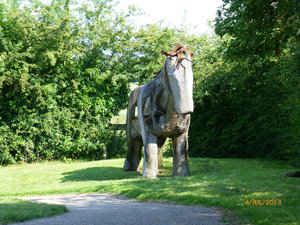Advertisement

 Horse sculpture by Nantwich Basin
Horse sculpture by Nantwich Basin
I'm not often too impressed by the art and poetry of the canal but this horse was magnificent. This was hidden from view until almost the last minute as the towpath climbed in preparation for a bridge.0 locks, 275 in total
Little bit fed up – I've just spent 45 minutes writing today's blog and the session timed out – all lost so starting again!
Yesterday evening Hattie had a major grump. We were outside the boat whilst I was on the phone to Sam when Hattie started to softly growl, interspersed with single woofs – a Sainsbury carrier bag full of rubbish was floating very slowly past our boat. Hattie was like a statue – just her head almost imperceptibly moving as the bag did. When the angle of view became too acute she leaned forward, still not moving her feet, until she was almost on tiptoe and hanging over the edge of the boat, still growling and woofing. She finally stopped when the bag had travelled the whole length of the boat!
Nantwich means 'trading settlement of famous buildings' – whether the trade or the discovery of salt springs came first I do not know. In 1583 there was a fire that burned for 21 days, destroying much of the town but following a
national collection Queen Elizabeth I had the town rebuilt. Many half-timbered buildings remain today which help give Nantwich its character and beauty, although the town doesn't seem to seek tourists.
The 14
th century St. Mary's Church – another fine red sandstone building – was very welcoming and I went round it to the accompaniment of an ensemble practising for a later concert. There were small information plaques detailing points of interest, two of which I found particularly interesting. In 1615 the floor was raised by about 20” and the extra space filled with sand to combat the damp from an underground spring and to cover the numerous coffins in shallow graves beneath the church. The Victorians removed the sand but this century the floor has had to be raised once again and it is possible to see the old levels in some places through transparent covers instead of standard flooring. One of these view holes showed a ledge that originally went all round the inside wall of the church. In medieval churches there were no pews – the congregation would stand or kneel for services. The sick and elderly would sit on this

 Nantwich Aqueduct
Nantwich Aqueduct
Very similar to the one at Stretton.ledge, hence the expression 'the weakest go to the wall'.
Unable to use the weather as an excuse, I did more painting this afternoon. The areas needing work were low down, level with the grass. I tried just pulling the grass out from the edge of the mooring but ended up cutting it with an old pair of scissors – much easier than shears, surprisingly.
Advertisement
Tot: 0.054s; Tpl: 0.012s; cc: 7; qc: 23; dbt: 0.0273s; 1; m:domysql w:travelblog (10.17.0.13); sld: 1;
; mem: 1.1mb

 Horse sculpture by Nantwich Basin
Horse sculpture by Nantwich Basin
 Nantwich Aqueduct
Nantwich Aqueduct




